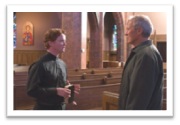


Social Injustice Played Out Eastwood Style
Clint Eastwood’s latest film centers on a myriad of social issues and sends a message of conflict resolution as a means to an end. The film also shows us the upside of accepting change and different points of view. Lastly, it teaches how to mentor our youth and the lessons that can be learned in such positive relationships. The film is a brilliant realization of what could happen if people became more accepting of others.
Eastwood at age 78 plays Walt Kowalski a retired Detroit auto worker that built the pristine car he defines himself through, his prized ‘Gran Torino.’ The 1970’s car itself serves as a reminder of the days when the auto industry in this country was on top and its factories were filled to the brim with workers. Walt’s also a Korean War vet and a racial bigot whose language is worse than Archie Bunker’s on the 1971 TV series ‘All in the Family.’ If you know all of these elements up front then consider yourself forewarned, it’s tough to hear all the racial slurs and no holds are barred in this film. (I even heard some new ones.)
The beginning of the film introduces Walt as the snarling, sneering, grunting, sighing, hissing personality that he is. He is not a pleasant character to be around. His own son has struggled throughout his adult life with his dad as well as his immediate relatives. Walt even takes on his belated wife’s priest Father Janovich, played convincingly by Christopher Conley, as he attempts to help Walt after her death. All goodwill gestures are greeted with distain. The great thing about Father Janovich is that he doesn’t give up. He goes so far as to seek Walt out at the local neighbor bar and they end up having a drink together. Their discussion is telling as Walt proclaims that he survived the Korean War and Father Janovich states, “Seems like you know a lot more about death than you do living”.
Walt lives in a neighborhood north of Detroit, Michigan that has be integrated by people from the Hmong culture. Hmong refers to an Asian ethnic group in the mountainous regions of southeast Asia and are also one of the largest sub-groups southern China. Large populations can also be found in northern Vietnam, Laos and Thailand. ‘Walt the Bigot’ shows his dislike of his neighbors by spitting, growling and sneering at them. A change of events happens when the next door neighbor a teenager named Thao, played wonderfully by Bee Yang attempts to steal Walt’s Gran Torino as initiation scheme into the neighborhood gang.
Thao is a reluctant participant in the theft all along and has been trying to avoid the gang altogether. The story shifts as Walt decides to mentor the timid, fatherless boy and teach him the ways of the world.
These scenes were my favorite as Walt begins to soften and Thao begins to blossom under Walt’s wing. The Hmong neighbors rally around Walt as he has attempted to keep the gang at a distance. He boldly yells at them, “Get off my lawn!” as he points his hand into the shape of a gun and pulls the imaginary trigger. Its high drama at this point, with high stakes.
In a scene where Walt rescues Thao’s sister Sue played sweetly by Ahney Her, we witness a conflict between Walt and some teens who are about to hurt Sue and her friend Trey played byScott Eastwood, Clint’s son in real life. This scene also sets the tone for further conflict as we are slowly prepared for it by a well timed script.
This film is rated R for the language and violence, although the messages presented in the film are worth viewing if you can get past these elements. Clint’s performance is over-the-top, but this is an extreme film with an important message. We also should remember that this is Hollywood’s adaption of social injustice in our country and has the license to be to dramatic. I’d expect no less.
Sarah Adamson © 2009
